Return to Standish families of the Manor of Duxbury.
![]()
The Pele Tower on the Manor of Duxbury Lancashire England.
The Standish Family of the Pele Tower 1303 to 1647.
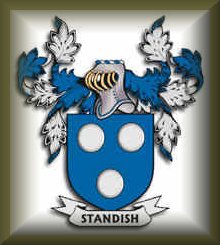
Direct Link Myles Standish 1584.
The evidence of Eleanor Johnson.
DUXBURY MANOR.
Deowucs burh, 8th century, Dukesbiri, 1227, Dokysbiri,
Dockesbyry, 1292.
This Manor has an area of 1,012 acres. The River Yarrow, flowing to the southwest, crosses it; turning sharply to the northwest the river then forms part of the township boundary. The portion within the bend of the river contains the district of Burgh. The southern boundary of the main portion of the township is the Ellerbeck, flowing west to the Yarrow and dividing Duxbury from Adlington and Coppull. From the Yarrow the surface, rises somewhat steeply, attaining a height of 325 ft. There is no village or hamlet in the township, about a third of the area being occupied by the parks of Duxbury Hall and Ellerbeck. The population in 1901 was 282.
$$$. The Billion-Dollar Question.
Is this Monument in
Duxbury New England USA the Myles Standish or Myles Haydock Monument?
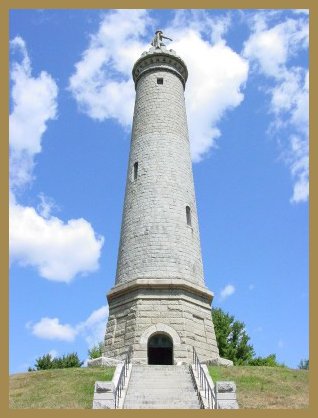
Should it be (a) the Myles de Standish Monument or (b) the Myles
de Haydock Monument?
Whose Dna is lying in the grave of Myles in Duxbury USA, is it the Male line Dna of the Standish family or the Male line Dna of the Haydock family?
(a) If Myles Standish were descended from the Standish family of the Pele Tower upon the manor of Duxbury his male line Dna would be that of the de Haydock family.
(b) If Myles Standish were descended from the Standish family of the Burgh upon the manor of Duxbury his male line Dna would be that of the de Standish family of Standish.
The Grave of Myles Standish.
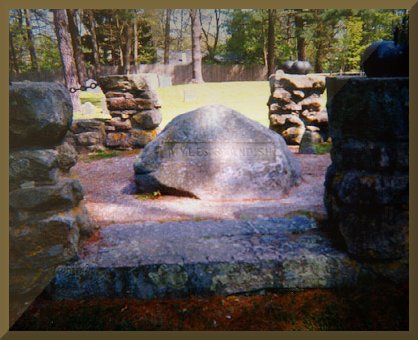
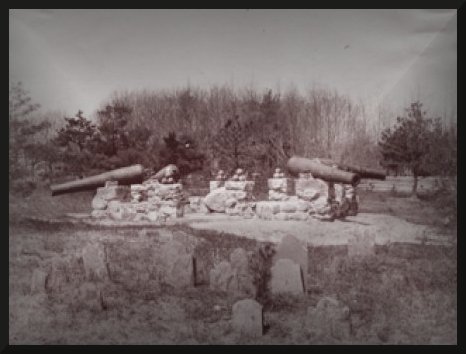
The Church of St. Laurence Chorley Lancashire England.
Beneath the high alter (inside the Chancel Arch) are buried within the Standish family crypt many generations of the Standish family descended from Hugh de Haydock de Standish of Duxbury Manor.
Could a match be made between the ancient Dna in theChurch of St Laurence and the Dna of Myles Standish in his grave in Duxbury
USA? Prof. David McConnell of Trinity College Dublin Ireland believes
that the billion-dollar question can be answered if his team had access to the
Dna in the crypt at the church of St. Laurence and the Dna of Myles Standish
from his grave in Duxbury USA.
The flag of the United States of America hangs above the ancient Standish family pew the private seats for the family of the Lords of Duxbury Manor from the year 1595.The flag was given to the Church by American soldiers stationed in England during World War 2 to commemorate Myles Standish and the Standish families of Duxbury Manor.

The Standish family of the Pele on the Manor of Duxbury are
descended from Alice Standish (sister of Jordan - Lord of the Manor of
Standish) and her husband Hugh de Haydock. Their son Robert de Haydock was the
Rector of Standish from 1275 to 1301. The Standish family papers from that
period of time do not indicate the name of Robert de Haydock’s wife but they do
very clearly name his children Hugh – Nicholas – Matilda. The Standish family
papers clearly show that the son of Robert de Haydock was the founder of the
Standish family of the Pele upon the Manor of Duxbury. Hugh de Haydock de
Standish dropped the de Haydock from his name between the years 1315 - 1326 and was known
thereafter as Hugh de Standish. Hugh de Haydock could clearly change his name
but NOT his male line DNA profile.
![]()
Lords of the Manor of Duxbury, 1303-1647.
The Family Tree of the Standish Family of the Pele - Manor of Duxbury.
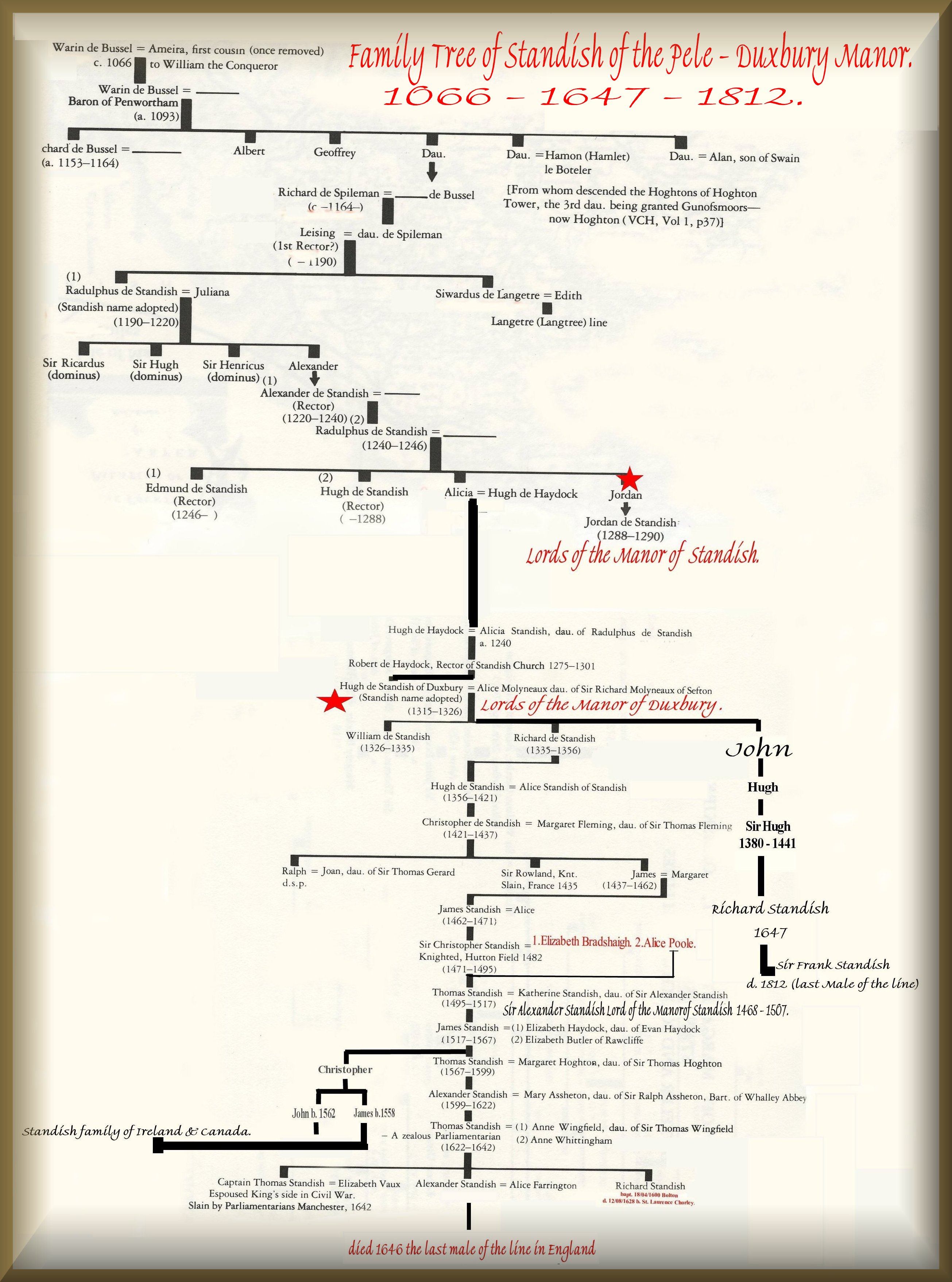
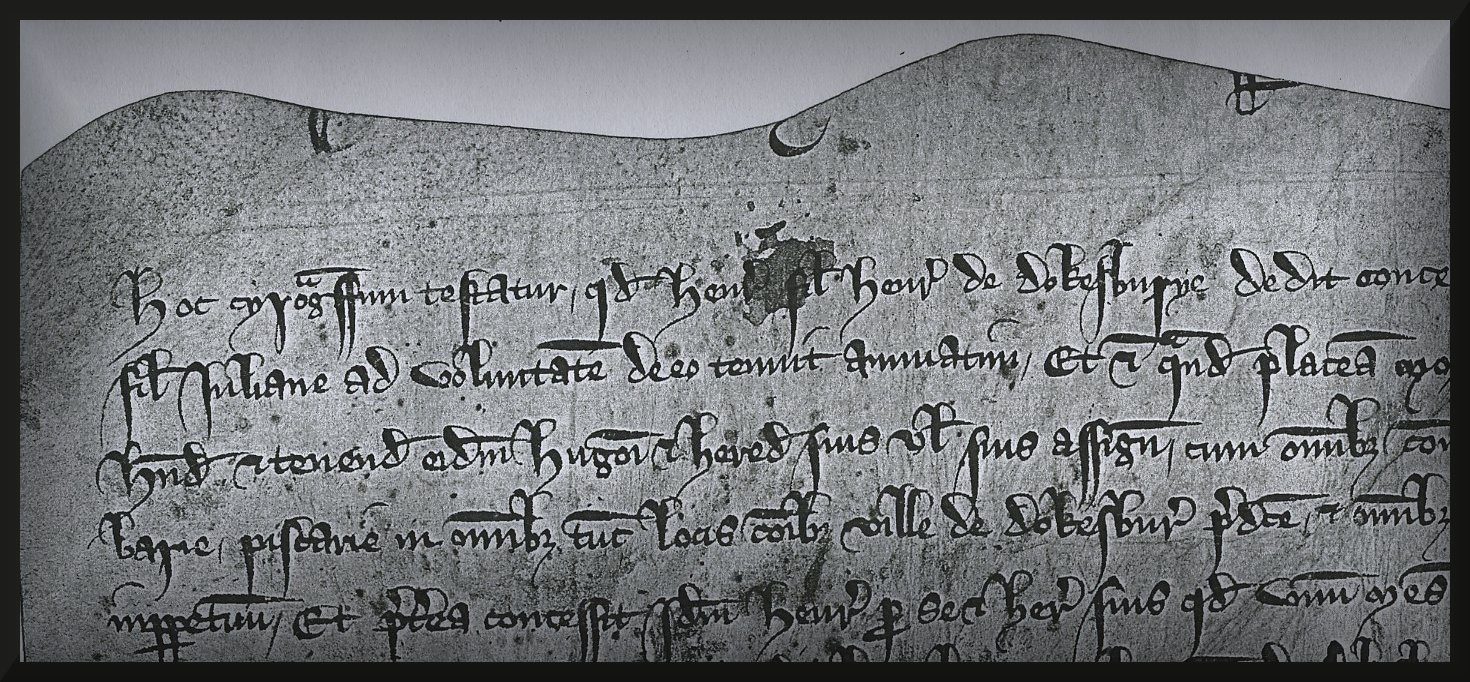
DP 375/8/21 - year 1303 -Lancashire Record Office.
1303. In the year 1303 Hugh de Haydock de Standish of the House of Standish buys land upon the Manor of Duxbury. Hugh de Haydock de Standish from the house of Standish of Standish arrived in Duxbury in the year 1303 and built his Pele Tower on the Manor of Duxbury between the years 1303 - 1315.
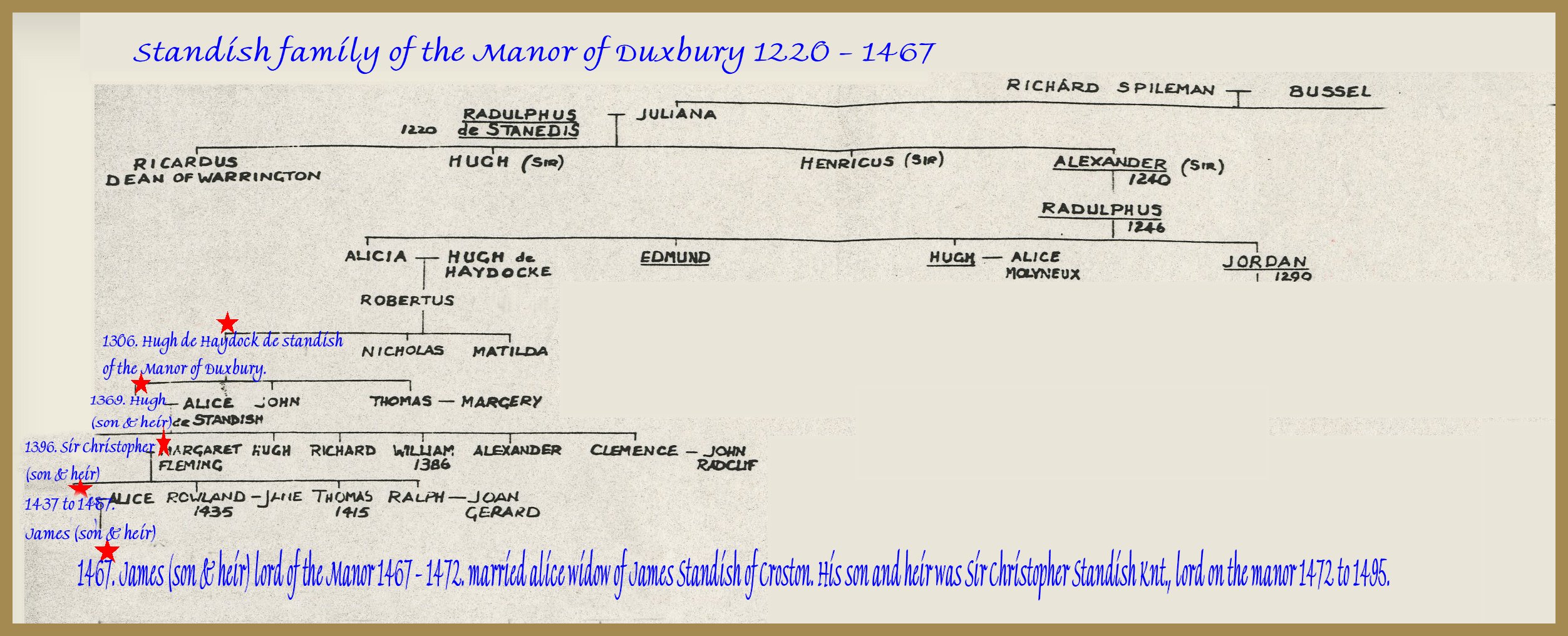
1301. Hugh de Standish was the founder of the Standish family of the Pele at Duxbury Manor.
Alice daughter of Richard de Molyneux of Sefton was in 1306 contracted in marriage to Hugh de Standish, she being under age ; Croxteth D. Genl. i, 5.
Hugh de Standish in 1315 summoned Nicholas de Bolton and Margery his wife to warrant him in the possession of lands in Duxbury ; - De Banco R. 211, m. 171 d.
In 1321 Hugh de Standish acquired the moiety of a messuage and land in Duxbury from Adam the Wright of Wigan and Cecily his wife ; Final Con, ii, 42.
Children of Hugh and Alice
(de Molyneux) de Standish:
1. William de Standish, eldest son and heir, was lord of the manor of Duxbury, 1326-1335, dying about 1335.
2. Richard de Standish, of Duxbury, second son.
3. John de Standish, of Duxbury, living in 1351. Roger de Chisenhale granted to Sir Henry le Waleys, Rector of the Church of Standish, 3 acres and 29 perches of meadow in Worthington for a term of 6 years commencing . . . 1336, and if the said Henry die within six years then the said Roger grants for him and his heirs, that John son of Alice de Standish shall have it for the remainder of the term, paying annually one rose. Witness: John de Standish. (SD 24)
William son of Hugh and Alice de Standish was a plaintiff regarding the lands assigned to Alice his mother in 1332 DeBanco R. 291, m. 185.
William de Standish and William de Burgh in 1333 granted land in Duxbury to Henry Knoute ; Standish D. [Local Glean, ii), no. 23.
The lands assigned to Alice were in 1334 released by her son Richard de Standish ; ibid. X, i, 6.
Richard son of Hugh de Standish in 1335 made a grant of lands received from William his brother ; Standish D. {Local Glean.), no. 25.
In 1326 Margaret widow of Hugh de Standish claimed dower in lands in Duxbury and Standish held by William son of Hugh de Standish ; De Banco R. 264, m. 49 d. Hugh therefore had been married more than once.
The identity of Hugh de Haydock de Standish


Among Kuerden’s abstractsare several referring to Hugh son of Robert de Haydock, rector of Standish, and the identity of Hugh de Haydock and Hugh de Standish appears to be established by grants from Robert son of William de Worthington to Hugh de Haydock in 1299, by Hugh de Haydock to William son of William de Worthington and Mabel his wife in the same year, and by William son of William de Worthington to Hugh de Standish of "what he held of him" in 1304. ; Kuerden MSS. ii, fol. 145. A number of short notes on Standish of Duxbury deeds are preserved in Kuerden’s MSS. ii, fol. 144, Sec. ; v, fol. 145 ; vi, fol. 96. They do not show clearly how the manor came to the Standish family. In 1359 Henry son of Adam de Duxbury sold to Nicholas le Norreys the reversion of a messuage and land held by Ellen widow of Robert del Burgh for her life ; Final Cone, ii, 161. Robert son of Nicholas le Norreys in 1384 sold the reversion to Hugh de Standish the elder ; ibid. iii. 19. Between 1381- 1384 Robert son of Nicholas le Norreys gave and released to Hugh de Standish two-thirds of the manor of Duxbury. Kuerden MSS. v, fol. 145.
1326. William deStandish, lord of the manor of Duxbury, 1326-1335, dying in 1335 , eldest son of Hugh and Alice (de Molyneux) de Standish.
1335. RICHARD de STANDISH, lord of the manors of Duxbury and Heapey, 1335-1356, second son of Hugh and Alice (de Molyneux) de Standish, succeeded to the lordship in 1335 on the death of his brother William and died about 1356. He married Clemency who survived him, and he is mentioned frequently in the acquisition of the manor of Standish Richard son of Hugh de Standish granted lands in Duxbury to William de Burgh and Joan his wife, in which he had been enfeoffed by William de Standish his brother, with reversion to the heirs of the said Richard. Witness: John de Standish. Dated, 1335. (SD 25). In 1350, Richard de Standish made a settlement of his manors of Heapey and Duxbury, with lands in Worthington, Heath Charnock and Hyndley. (Kuerden MSS V fol. 145b No. 55). With his brother John he signed as a witness, May 3, 1351. (SD 37).
In 1350 Richard de Standish made a settlement of his manors of Heapey and Duxbury, with lands in Worthington, Heath Charnock and Hindley. Kuerden MSS. v, fol. 14, no. 55.
Children of Richard and Clemency de Standish of Duxbury.
1. Hugh de
Standish, lord of the manor of Duxbury, 1356-1421. #
2. Agatha de Standish, living
1354, m. Henry son of Adam de Duxbury.
3. William de Standish, d. y.
4. Alice de Standish, d. y.
5. Clemence de Standish, d. y.
Hugh is first mentioned in grants of land in
Standish and Langtree made him by his father Richard in 1343 and 1346 ibid.
no. 83, 84. He appears to have been in possession by 1356 ; see several
abstracts in Kuerden MSS. v, fol. 145. He is described as 'the elder ' in 1384.
1356. HUGH de STANDISH, lord
of the manor of Duxbury, 1356-1421, son of Richard and Clemency de Standish of
Duxbury, died about 1421, when he made his will which is preserved in the
Kuerden MSS. He married, ca. 1369, Alice de
Standish (No. 35, q. v.), daughter of Henry de Standish, lord of the manor or
Standish and his wife Joan de Worseley. He married, second, Elizabeth who
survived him. She was living about 1432, and was widow of Pennington,
at the time of her marriage to Hugh.
Hugh was in possession of the manor of Duxbury in the time of Edward III and Richard II.
In 1378 Hugh de Standish received licence for his oratories at Duxbury and Bradley. Lich. Epis. Reg. v, fol. 31.
Document Lich. Epis. Reg. v, fol. 31 confirms that the Standish family of Duxbury Manor had their own private Chapel in their Pele Tower and also at their other family residence Bradley Hall in the township of Standish.
One very important consequence of these private Chapels
(Oratories) was that family baptisms in these private Chapels went unrecorded.
Oratory
(Latin oratorium,
from orare, to pray)
As a general term, Oratory signifies a place of prayer, but technically it means a structure other than a parish church, set aside by ecclesiastical authority for prayer and the celebration of Mass. Oratories seem to have originated from the chapels erected where the faithful resorted to pray, and also from the necessity of having a place of worship for the people in country districts when churches proper were restricted to cathedral cities. Private oratories were originally for the celebration of Mass by bishops, and later private oratories were attached to the residences of noble families.
In 1416 Hugh de Standish the elder was exempted from service on juries, Kuerden, loc. cit. At the same time a Hugh de Standish, the younger, was serving with the armies in France ; Dep. Keeper's Rep. xliv, App. 558.
Children of Hugh and Alice
(de Standish) de Standish of Duxbury.
1. Christopher de Standish, eldest son, lord of the manor of Duxbury, 1421-1437.
2. Hugh de Standish, the
younger, 1384, second son; served with the armies in France, 1416.
3. Clemence de Standish (also called Clementia or Clemency).
1421. CHRISTOPHER de STANDISH, Lord of the manor of Duxbury, eldest son of Hugh and Alice (de
Standish) Standish of Duxbury, possessed the manor from 1421 to
1437, and died about the latter year. He married, about 1396, Margaret Fleming,
daughter of Sir Thomas Fleming. (In 1396 a feoffment was made to Christopher
son of Hugh de Standish and Margaret his wife, daughter of Sir Thomas Fleming.
(Dods. MSS cxxxvi fol. 95).
Children of Christopher and Margaret (Fleming) Standish.
1. Ralph de
Standish, of Duxbury, d. s. p.; m. Joan Gerard, dau. of Sir Thomas Gerard.
2. Sir Rowland Standish, Knt.,
according to the 1613 pedigree, served in the French Wars, was made a knight,
and was slain about 1435, in the company of the Earl of Arundel. He was a
brother of James Standish of Duxbury (1442) and gave a relic of St. Lawrence to
Chorley Church. James Standish of Duxbury occurrs in 1441. (Pal. of Lanc. Plea R. 3m. 12b).
3. James Standish, lord of the manor of Duxbury, 1437-1462.
In the year 1418 Christopher Standish and his sons Ralph and Rowland attested Chorley deeds. ; Add. MS. 32105, nos. 557,568, 548
In the year 1426 John de Pilkington transferred lands to Rowland de Standish of Duxbury Manor. Laurence Standish Lord of the Manor of Standish and husband of Lora Pilkington witnessed the deed. Myles Standish is said to have named his own daughter Lora in honour of Lora Pilkington.

Arms of Pilkington.

DP 375/466/5 - Lancashire Record Office. Grant of Land Pilkington to Standish.
The words of John de Pilkington in the year 1426.
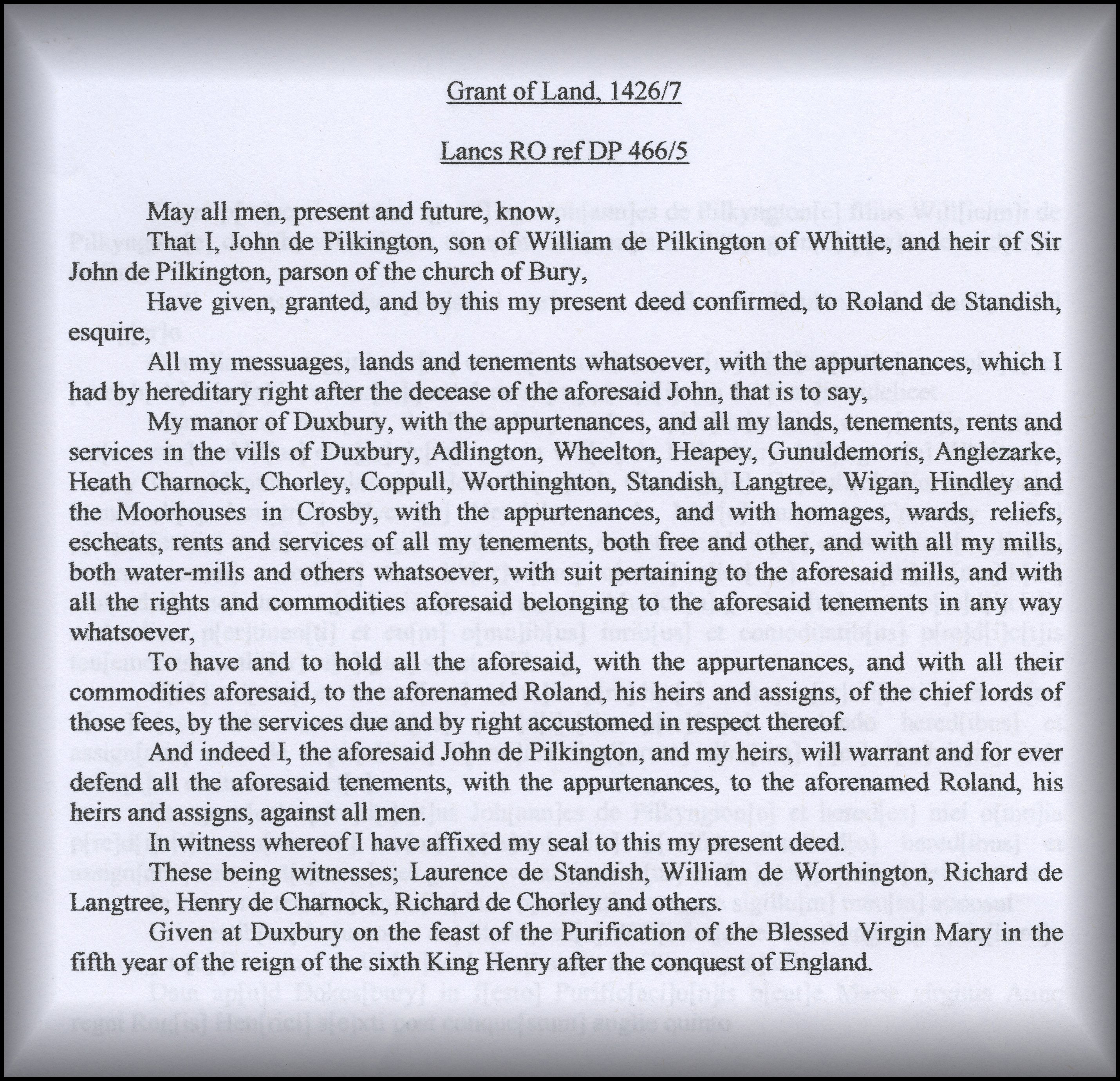
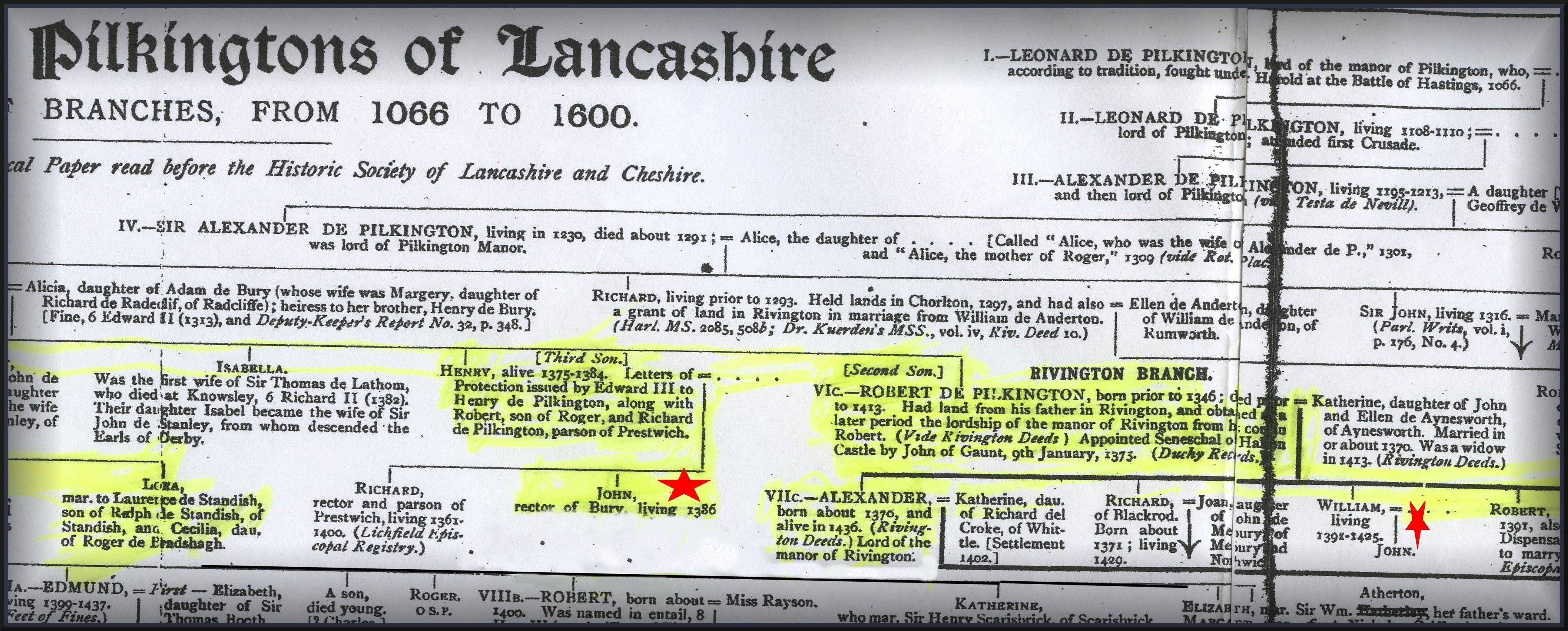
John de Pilkington son of William - Sir John de Pilkington Rector of Bury - Lora Pilkington wife of Laurence Standish, Lord of Standish.
1437. JAMES STANDISH, lord of the manor of Duxbury, 1437-1462 son of Christopher and Margaret (Fleming) Standish, died about 1462. He married Margaret, who married, second, Richard Birkhead. He attested a grant in 1458 (SD 145) and was also mentioned in 1462. (Pal. of Lancs. Writs Proton ).
1441. James Standish of Duxbury
occurs in 1441 ; Pal. of Lanc. Plea R. 3, m. 12b
1458. James Standish, attested a grant in 1458 ; Standish D. (Local Glean) no. 145.
1462. James Standish also occurs in 1462 ; Pal. of Lanc. Writs Proton.
Kings pardon to James Standish in the year
1446/7.
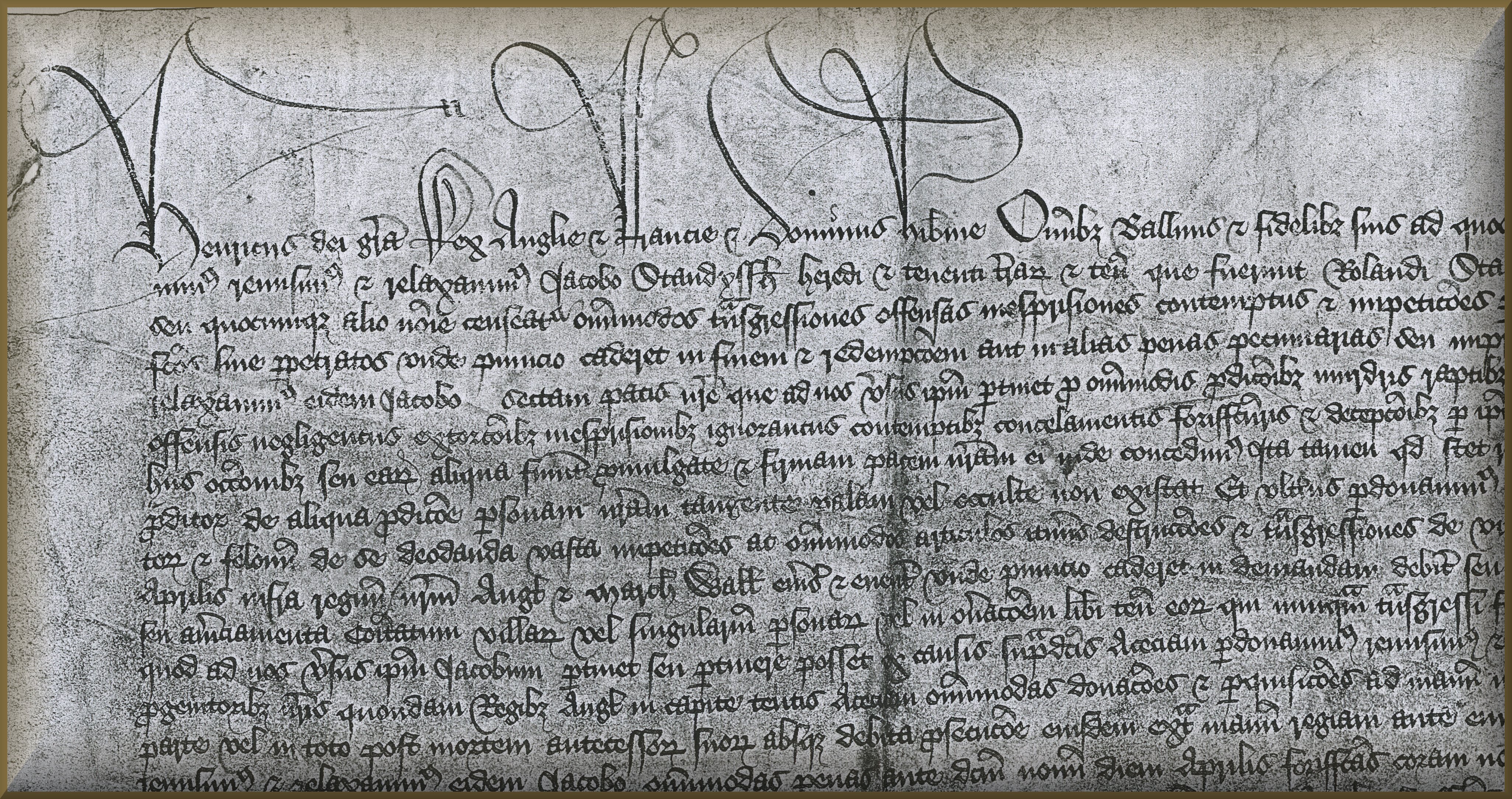
Henry, by the grace of God, King
of England and France, Lord of Ireland,
To all
my bailiffs and faithful subjects to whom this present letter may come;
greetings.
May
you know that we, of our special grace, and from certain knowledge, and of our
own free
will, have pardoned, remitted and released James Standish, (heir and tenant of
the lands and tenements
which belonged to Roland Standish esquire), also called James Standish of
Duxbury in the County of Lancaster, Esquire,
or by whatever other name he may be known,
All
manner of trespasses, offences, misprisions, contempt’s and impeachments done
or perpetrated by the same James before the ninth day of April last past,
contrary to the form of the statutes of liveries of clothes and hoods, in respect
whereof punishment might have fallen due by way of a fine in redemption, or of other monetary
penalties, or imprisonment, the aforesaid statutes notwithstanding;
And
over this, of our free will and knowledge aforesaid, have pardoned, remitted
and released the same
James from liability to Suit for Breach of our Peace which appertains to us
against him for all manner of treasons, murders, rapes of women, rebellions,
insurrections, felonies, conspiracies, collusions and embraceries [briberies of
jurors], and other trespasses, offences,
negligence’s, extortions, misprisions, infamies, contempt’s, concealments
forfeitures and deceptions done or perpetrated by the same James in any
way whatsoever before the said ninth day of April,
And also of outlawry, if
any shall have been pronounced against the same James by virtue of these occurrences, or any of them, and we grant
him our firm peace in respect thereof,
Such
that, however, he shall stand to right in our court if anyone should wish to
speak against him
concerning the premises or any of the premises.
So long as the same James
be not a traitor, involved, openly or secretly, in any treason touching our
person.
And
further we have pardoned, remitted and released the same James from all
manner of fines for
escapes of felons, chattels of felons and fugitives, chattels of outlaws,
suicides, deodands, wastes, impeachments, and all manner of articles liable to
be heard in our courts, destructions and trespasses in the greenwood or
the chase, sale of wood (within forests and without),
and of any other things whatsoever, which happened or arose before the said
ninth day of April, within our realm of England and the Marches of
Wales,
In
respect whereof punishment might have fallen due by way of a demand due, or a
fine and
redemption, or other monetary penalties, or forfeiture of goods and chattels,
or imprisonment or
amercement, of communities, of towns, or of individual persons, or in the
charging of a free tenant of his who ever trespassed, as also of heirs,
executors or lands of tenants, [by the imposition of escheators, sheriffs,
coroners and other such,
And
from all that which pertains or may be able to pertain to us against the same
James from the causes
above.
And also we have pardoned,
remitted and released the same James all manner of gifts, alienations and purchases done and had by him
concerning lands and tenements held in chief, of us or our progenitors,
former kings of England,
And also all manner of
gifts and purchases done and had into mortmain without royal licence.
And
indeed all manner of intrusions and entries into his inheritance, in part or in
whole, after the death
of his ancestors, done without due process of the same out of the royal hand
before the same ninth day of April,
together with the issues and profits received there from in the mean time.
And
over this, we have pardoned, remitted and released the same James all manner of
penalties forfeited by
the same James for any reason, both to us and to our most dear father deceased,
and levied for our use, before the same ninth day of April, and all manner of
sureties for breach of the peace.
And
also thirds, and thirds of thirds, of all manner of prisoners of war taken in
war, due, appertaining
or belonging to us, by the same James, on the said ninth day of April in any
way whatsoever.
And
indeed all manner of trespasses, offences, misprisions, contempt’s and
impeachments done or perpetrated by the same James before the same ninth day of
April contrary to the form of any statutes, ordinations and provisions
whatsoever made or enacted before the said ninth day of April concerning
the purchases, acceptances, readings, publications, notifications and
executions whatsoever applied before the said ninth day of April, and
of all other statutes, ordinations and provisions by reason of which any suit
against the same James, by bill or by writ of Praemunire done or perpetrated
before the same ninth day of April is able to be made, as also of any other
statute whatsoever,
These
statutes, ordinations and provisions notwithstanding.
And also we have pardoned,
remitted and released the same James all manner of fines, admissions, issues,
forfeits, relief’s, scutages, and all manner of debts, accounts, loans, arrears of farm, and due and
pertaining to us before the first day of September in the twenty fifth year of our
reign,
And also all manner of
actions and demands which we, alone, or jointly with other persons or another person, have or shall be able
to have against the same James for any of these fines, issues, reliefs, scutages, debts, accounts, loans and arrears due
to us before the same first day of September.
And also outlawries
published upon the same James for any of the above said causes, wholly excepting all manner of debts and accounts dm
and pertaining to us which by force of our letters patent, or of our
writs of great or privy seal, or by instalments or assignments of debts, have
been postponed,
Such that our present
pardon regarding the premises, or any of the premises, should not tend to the damage, prejudice or derogation of
any other person, or at most, to our own person only.
Provided always that this
our pardon is worth nothing at all, and should not be apportioned or allowed,
and should not in any way extend, to Eleanor Cobham, daughter of Reginald de Cobham, knight, John Bolton of Bolton
in the County of Lancaster, Bladesmith, William Wyghale, late Keeper of
our gaol of Nottingham, or any of them, nor to the felony, lately perpetrated, of the death of Christopher Talbot,
knight, feloniously killed.
Nor does our present
pardon, nor any other pardon of ours, in any way extend to any other wool or
woolfells, or other merchandises of the staple, carried and transported to any
foreign parts outside our realm of England,
contrary to the form of the statute enacted in our parliament held at
Westminster on the day after Saint Martin's day in the eighteenth year of our
reign, or of any other statute whatsoever,
Nor to
any forfeitures appertaining or belonging to us in this regard.
Nor to exonerations or
acquaintances of any persons whomsoever of punishments to be made, according
to the form of the same statutes, for any wools or woolfells, or other merchandises of the staple, carried or
transported to any foreign parts contrary to the form of the same
statutes.
Nor does our present
pardon, nor any other pardon of ours, in any way extend to any of our great
accountants, that is to say, to the Treasurers of Calais and of our Household,
the Victuallers of Calais, the Chamber, Chester, North wall et South wall, The
Keepers of the Wardrobe and of our
Household, or the Keepers of our Great Wardrobe, or the Keepers or Clerks of
our Wardrobe, die Clerks of our Works, the Constables of Bordeaux, die
Treasurers of our Land of Ireland, and the Receivers of our Duchy of
Lancaster and of our Duchy of Cornwall, both
general and particular, so far as concerns their office, or their occupations,
or tiiat of any of them.
In
witness whereof we have caused these our letters to be made patent.
Witnessed
by me myself at Westminster on the twelfth day of February in the twenty fifth year of our reign.
Shipton [clerk]
By the same King in parliament.
Children of James and Margaret Standish.
1. James
Standish, lord of the manor of Duxbury, 1462-1471.
2. Hugh de Standish, living,1473.
Note re - Bradley in Standish township:Henry de Langtree gave Bradley to Hugh son of Robert de Haydock, Rector of Standish (Kuerden MSS III W 26) which was perhaps the estate in Standish settled by fine in 1304 (Final Concords, I. 204).
Bradley was in 1471 in the possession of Christopher son of James Standish of Duxbury.
1468. James Standish of Duxbury in 1468 gave certain lands in Standish, Worthington and
Langtree to trustees, who re-granted them to James's son Christopher and
Elizabeth daughter of William Bradshagh of Haigh ; Kuerden MSS. vi, fol. 97,
no. 98, 99. For marriage dispensation see Lich. Epis. Reg. xii, fol. 148A.
Christopher son and heir of James Standish occurs in 1471 ; Kuerden, loc. cit.
no. 101.
In 1473 Margaret widow of James Standish of Duxbury, esq., and wife of Richard Birkhead, claimed that Bradley in Standish should be settled on Hugh Standish, her son and heir by her
former husband ; Pal. of Lanc. Chan. Rec. Answers, i.
1462. James Standish lord of the Manor 1462 - 1471.
Children of James and Alice Standish.
1. Christopher Standish lord of the Manor 1471 - 1495.
1483. Alice widow of James Standish of Duxbury in 1483-4 made a grant to Sir Christopher, her son ; deed on visit, pedigree, 1613. Alice was still living in 1518. Sir Christopher was made a knight in the Scottish expedition of 1482. Metcalfe's Book of Knights. Duchy of Lancs. Inq. p.m. iii, no.107.
Alicia relict[a]
Jacobi Standish de Duxbury in viduetate mea demisi Christopher Standish militi
filio meo etc 1 R 3[Alice, the
relict of James Standish of Duxbury, in my widowhood, have devised to
Christopher Standish, knight, my son etc. 1 Richard III (1483/84)]
1471. Sir CHRISTOPHER STANDISH, Knight, lord of the manor of Duxbury, 1471-1495, was the son of James and Alice Standish. He died in September, 1495, leaving a son and heir, Thomas, only fifteen years of age.
Children of Sir Christopher
and Alice (Pole) Standish (2nd Wife):
1. Thomas Standish, lord of Duxbury, 1495-1517.
2. James Standish.
3. Alexander Standish.
4. Rowland Standish.
Thomas son and heir of Sir Christopher Standish was in 1497-8 engaged to marry Katherine daughter of Sir Alexander Standish Lord of the Manor of Standish. Standish Deeds. [Local Glean.), no.181,184.
Standish of Standish
Deed dated 21st November 1498.
Indenture
[in English] made between Sir
Alexander Standisshe, knight, on the one part, and Thomas Pole, knight, Thomas
Pole, esq., and Ralph Pole, gent., on the other. Reciting that the three last
mentioned parties had been enfeoffed by Sir Christopher Standisshe, knight,
deceased, of his lands in Lancashire, that with the profits and the marriage of
his heir they might pay his debts, marry his daughters, help his younger sons,
and do other things for his soul's well, as his will shows.
They with the
agreement of Dame Alice (Pole), late wife of Sir Christopher, and Thomas
Standisshe his son and heir, grant to Sir Alexander that before the feast of St
Nicholas (6th Dec.) next the said Thomas Standisshe shall by the grace of God
marry Katherine daughter of Sir Alexander, if the law of Holy Church will
suffer it and Katherine agree.
The trustees will
create a life estate for her of ten marks yearly in Heapey. When Thomas is xxi,
they will grant to him all manors, &c, except lands called Bradley and
Helyclif, which are the jointure of Dame Alice.
120 marks are to be
paid for the marriage.
Dated 21st Nov. 14th
year of Henry VII [1498]
Size of Deed 24 X 10 inches. Three tabs, two
seals crushed, one gone. - Earwaker, CLXXXI
There are very few deeds in the Standish of Standish collection, which mention the other notable Standish family of Duxbury. Here, however, we have a marriage between members of the two families. The close family connection is underlined by the words of Sir Christopher Standisshe “Thomas Standisshe shall by the grace of God marry Katherine daughter of Sir Alexander, if the law of Holy Church will suffer it” the very close family descent and thus the degree of relationship between Thomas and Katherine is recognised between the parties, hence the proviso relating to the law of Holy Church.
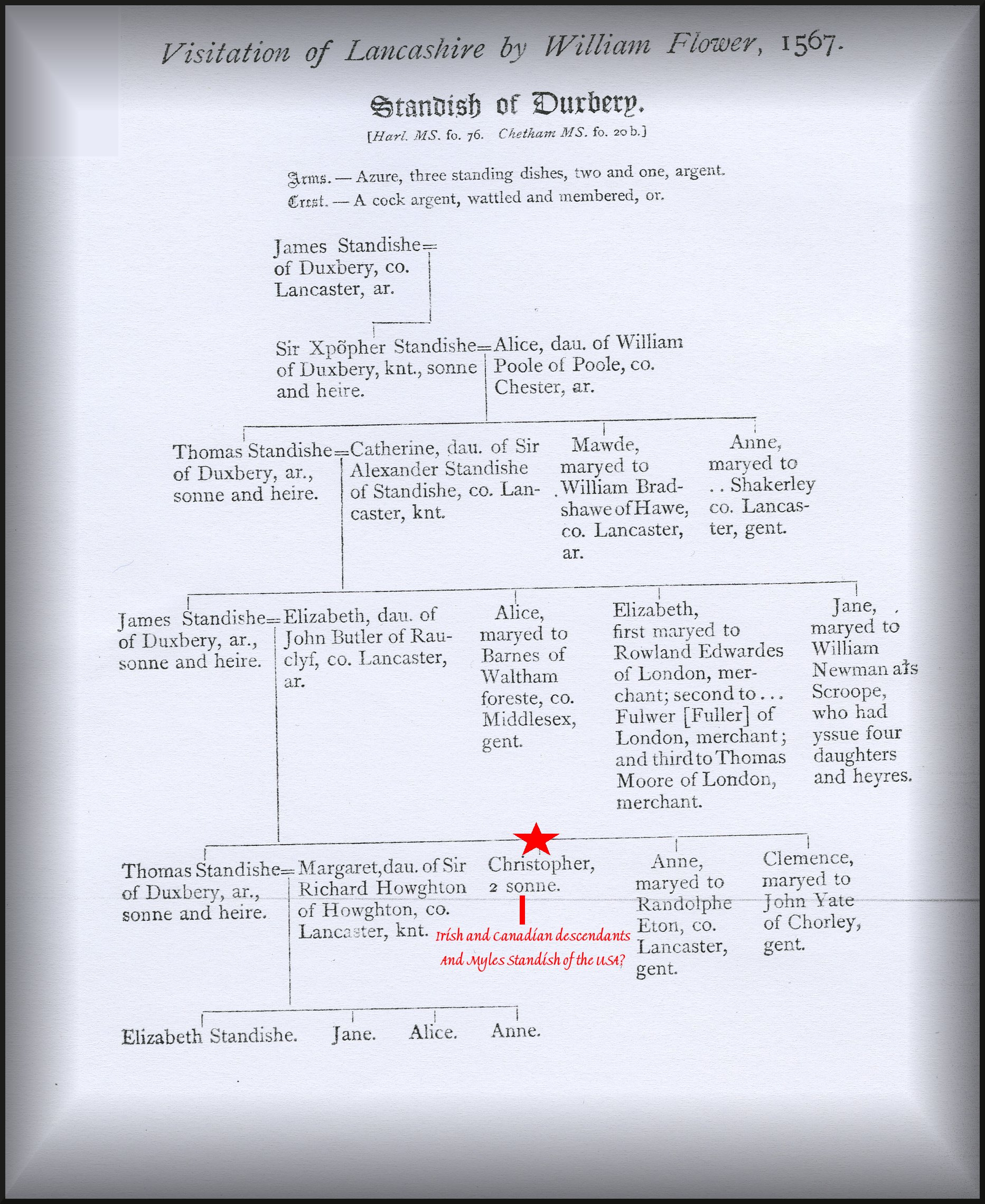
1495. THOMAS STANDISH, lord of the manor of Duxbury, 1495-1517, son of Sir Christopher and Alice (Pole) Standish of Duxbury, was born in 1480 and he died in 1517. He married, about 1497/8, Katherine Standish, daughter of Sir Alexander Standish of Standish, Knt. (No. 71). Articles of marriage between the parties named. (SD 181). Sir Thomas Pole, Knt., Thomas Pole, Esq., and Ralph Pole, gent, released Sir Alexander Standish, Knt., 20 marks due to the said Pole for the marriage of Katherine, daughter of Sir Alexander Standish with Thomas son and heir to Sir Christopher Standish, Knt. Dated,
1498/9. (SD 184).
Children of Thomas and
Katherine (Standish) Standish of Duxbury.:
1. Laurence Standish (died in infancy).
2. James Standish, lord of Duxbury, 1517-1567.
3. Alice Standish, m. . . . Barnes.
In 1506 Thomas Standish made a settlement of his manors of Duxbury and Heapey and various lands ;
FinalConc. iii, 162.
1517. JAMES STANDISH, lord of the manor of Duxbury, 1517-1567, the second son of Thomas and Katherine (Standish) Standish of Duxbury, was born in 1501 and he died about 1567. He was married, first, to Elizabeth Haydock, daughter of Vane (or Evan) Haydock. He married, second, 1536, Elizabeth Butler, daughter of John Butler of Rawcliffe. In the inquisition of his father, Thomas Standish, James, the son and heir, was sixteen years of age and provision was made for Thomas's mother Alice his wife Katherine, daughter Alice and son James, on his marriage with a daughter of Vane Haydock.
(Duchy of Lane. Inq. p. m. V No.
11).
1. James Standish Lord of the Manor of Duxbury 1517 - 1565 (the second or younger brother from the house of Standish) was the grandson of Sir Alexander Standish Lord of the Manor of Standish 1468 – 1507.
2.Katharine Standish the mother of James Standish was the daughter of Sir Alexander Standish Lord of the Manor of Standish 1468 – 1507. Katharine Standish was also the sister of Thurston Standish of the Burgh upon Duxbury Manor and the sister of Henry Standish the Bishop of St. Asaph.
3. In the year 1584 (birth date of Myles Standish) Thomas Standish was lord of the Manor of Duxbury, the family of Thomas lived at the Pele tower on Duxbury Manor. Thomas was the second son of James Standish Lord of the Manor of Duxbury 1517 - 1565. Thomas had one brother "Christopher Standish" who was the founder of the Irish and Canadian branches of the Standish family.
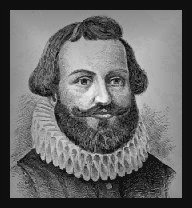
4.Therefore was Myles Standish (in common with his Irish and Canadian cousins) the great grandson of James Standish Esquire Lord of the Manor of Duxbury the second or younger brother from the house of Standish and thus Myles was the great great grandson of Sir Alexander Standish Lord of the Manor of Standish 1468 –1507?
5. The name of the wife of Christopher Standish is not mentioned in any of the Standish family papers and their marriage predates the start of church records, thus without her maiden name the land contained within her dowry cannot be determined. James Standish the son of Christopher is said to have married a sister of Myles Nightingale who was resident upon the Manor of Duxbury in 1582.
6. The documentary evidence does provides for a possible line of descent for Myles Standish. However the documentary evidence is to vague and insufficient to meet the legal requirement of “the balance of probability” needed to satisfy a court of law of the lawful descent of Myles Standish from this branch of the Standish familyThe evidence of Eleanor Johnson 1972.

The evidence of John Wilson 1914.
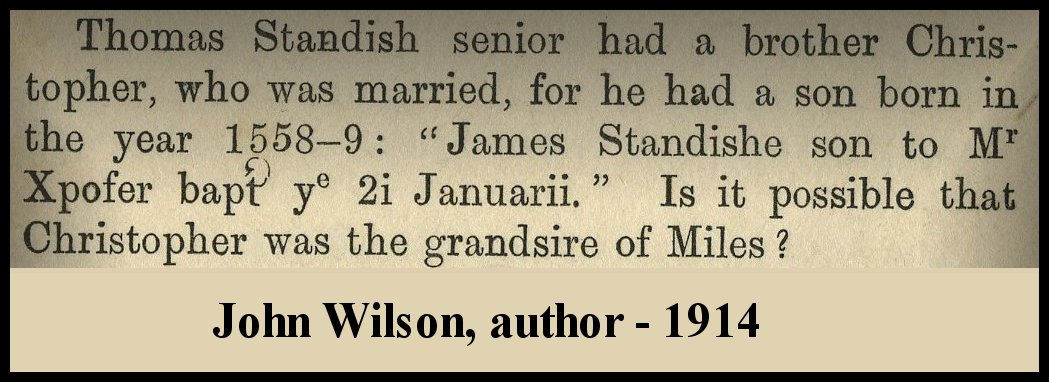
Children of James andElizabeth (Butler) Standish:
1. Lawrence Standish, in 1531 he is the son and heir apparent of James Standish of Duxbury and was espoused to Elizabeth Hoghton, daughter of Sir Richard Hoghton, he died before 1533. (Dods. MSS cxlii fol. 44).

2. Thomas Standish, Esq., lord
of the manor of Duxbury, 1567-1599. #
3. Christopher Standish ( founder of the Irish and Canadian branches of the Standish family).
4. Anne Standish, m. Roland
Eaton.
5. Clemence Standish, m. John Yates, of Chorley
Visit, of 1533 (Chet. Soc), 52. In 1531 Lawrence son and heir of James Standish of Duxbury was espoused to Elizabeth daughter of Sir Richard Hoghton; Dods. MSS. cxlii, fol. 44. He died before 1533.
James Standish recorded apedigree in 1533, his son Thomas being named as son and heir., and in 1564, he made a settlement of his manor of Duxbury and other lands. (Visit, of 1533 (Chet. Soc.) 52). In 1531, his son Lawrence was son and heir.
1567. THOMAS STANDISH, Esquire, lord of the manor of Duxbury, 1567-1599, son of James and Elizabeth (Butler) Standish, died in 1599. He married Margaret Hoghton, daughter of Sir Thomas Hoghton of Hoghton.
Children of Thomas and Margaret (Hoghton)
Standish:
1. Alexander Standish, lord of the
manor of Duxbury, 1599-1622.
2. Leonard Standish.
3.Elizabeth Standish.
4. Jane Standish.
5. Alice Standish.
7. Anne Standish.
Thomas made a settlement of the manor in 1581, and dying in 1599, left Alexander, son and heir, twenty-one years of age. (Duchy of Lane. Inq. p. m. XVII No. 54; Pal. of Lane. Feet of Fines, bdle. 43 m. 35). The will of Thomas Standish was made in 1593 and proved in 1600. (Piccope MSS (Chet. Lib.) IX 295). The manor at this time was stated to be held of the Queen in socage by rent of 12d.
1599. ALEXANDER STANDISH, lord of the manor of Duxbury, 1599-1622, son of Thomas and Margaret (Hoghton) Standish, was born in 1578, and he died in 1622. He married Alice Asheton, daughter of Sir Ralph Asheton, Bart., of Whalley Abbey, Lancashire in 1592.
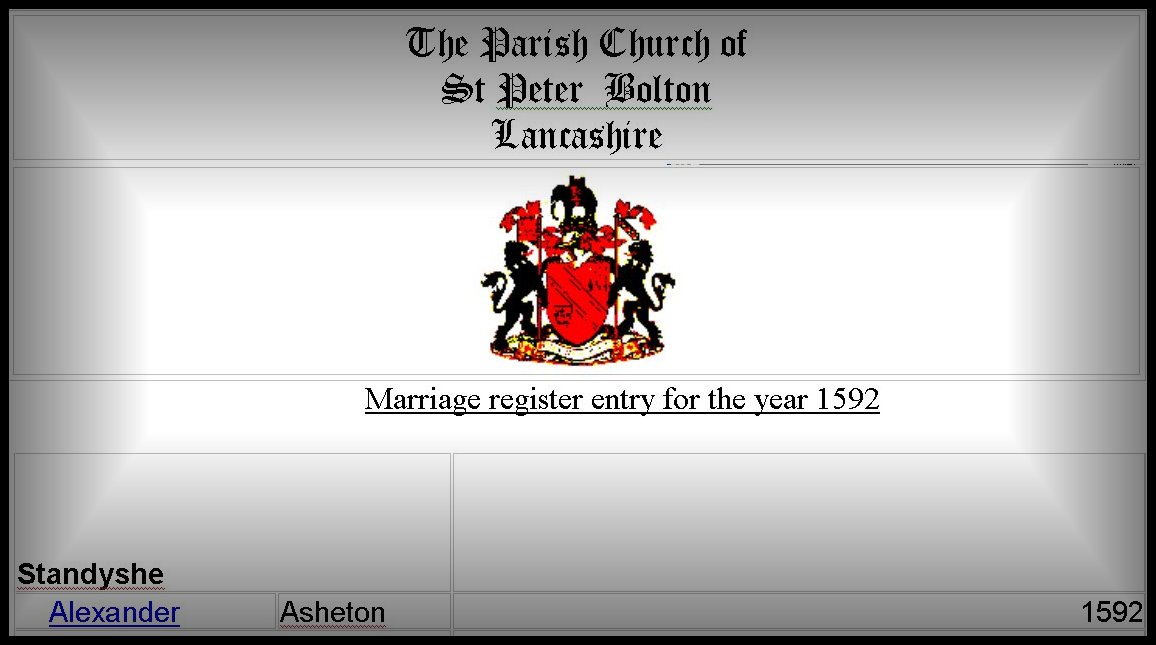
Children of Alexander and
Alice (Asheton) Standish of Duxbury:
1. Thomas Standish, Esq., b. 1593. buried church of St. Laurence Chorley 2nd October 1642.
2. Richard Standish.
3.Captain Alexander Standish, (will printed in Piccope's Wills (Chet. Soc.) II 141).
4. Captain Ralph Standish. buried church of St. Laurence Chorley 15th January 1638.
5.Joan Standish.
6. Alice Standish.
7.Anne Standish.
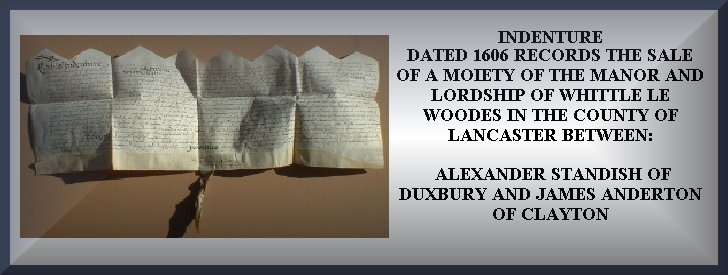
1623. (LANCASHIRE INQUISITIONS)
The will of Alexander
Standish of Duxbury Esquire.
Standish v Charnock. dispute 1618 -1622.
Lancashire Archives 397/13/15 date 1618.
Mittimus: To the Constableof Chester – to take into custody William Charnock gent. As a dangerous recusant 15th January 1618/1619. - Alexander Standish.
(Robert Charnock was outlawed for an unspecified reason and his brother John was hanged drawn and quartered for his part in the Babington Plot to assasinate Queen Elizaberth 1 in 1586.Robert Charnock was pardoned when James I came to the throne in 1611)
Lancashire Archives 397/13/15 date 1618 (take into custody William Charnock gent)
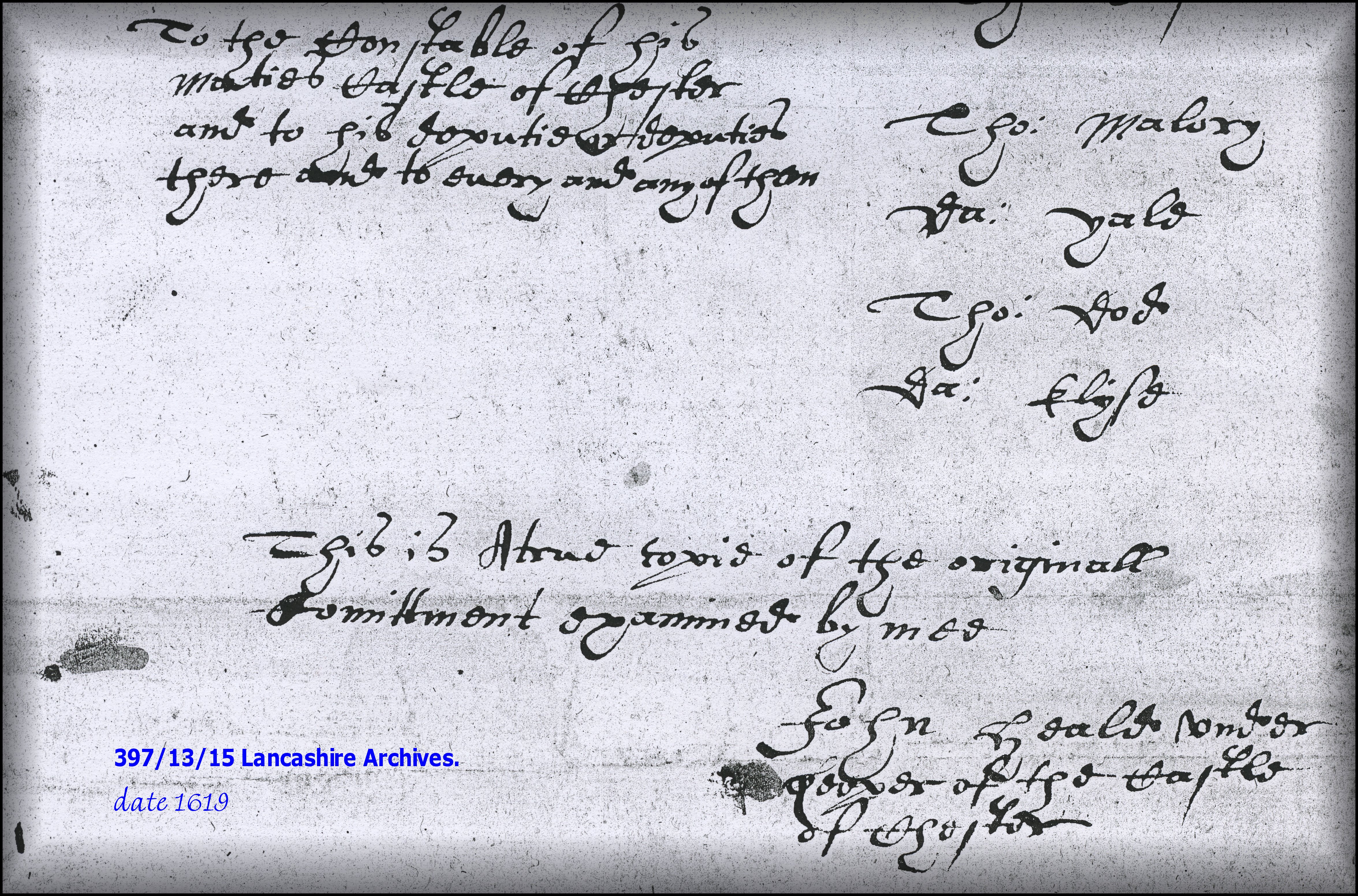
Alexander Standish made his will 31st March 1622 and stated in his will that it was his greatest wish “to be buried in the Chapel of Chorley above the steppes at the south of where my wife be buried and with her near the north wall of the said chancel” (Lancashire Archives - WCW Alexander Standish 1622)
Alexander Standish who died on the 18th June 1622 commenced preparations for his burial as detailed in his will dated 31st March 1622 to find that his right to burial in the Chapel of Chorley was being challenged in court by Thomas Charnock of Astley. (the Charnock and Standish families being joint owners of the Chancel in the Chapel of Chorley at that time)
Thomas Charlock’s action was retribution for the arrest of William Charnock on the 16th
January 1618 by the hand of Alexander Standish. The dispute was so acrimonious
that Thomas Charnock took his action to the Court of King James 1 and persuaded
the King to appoint a commission of judges to determine the outcome. King James
also strictly forbade any burials in the disputed Chancel and enjoined George
Comey, vicar of Croston, Richard Smith, curate of the chapel of Chorley, the
churchwardens of Chorley and the parish clerk not to make any grave in the
Chancel or allow any burial of the said Alexander Standish until the suit was
decided.
Alexander Standish was close to death by this date but he had
placed the dispute in the hands of the Standish family lawyers who produce a
very lengthy and detailed rebuttal of Thomas Charnock’s claims regarding his
family’s ownership in the Chancel of the Chapel of Chorley. The Standish family
lawyers won the argument and the parish register of the Chapel of Chorley
records the burial of Alexander Standish alongside his beloved wife Alice on
the 29th of June 1622.
The extensive legal argument put by the Standish family lawyers in
the court of Delegates - “Standish v
Charnock - burial place in Chorley Church” can be found in the Lancashire
Archives document 397/13/16 date June 1622.
Lancashire Archives document 397/13/16 date June 1622 - Standish burial place in the Chapel of Chorley.
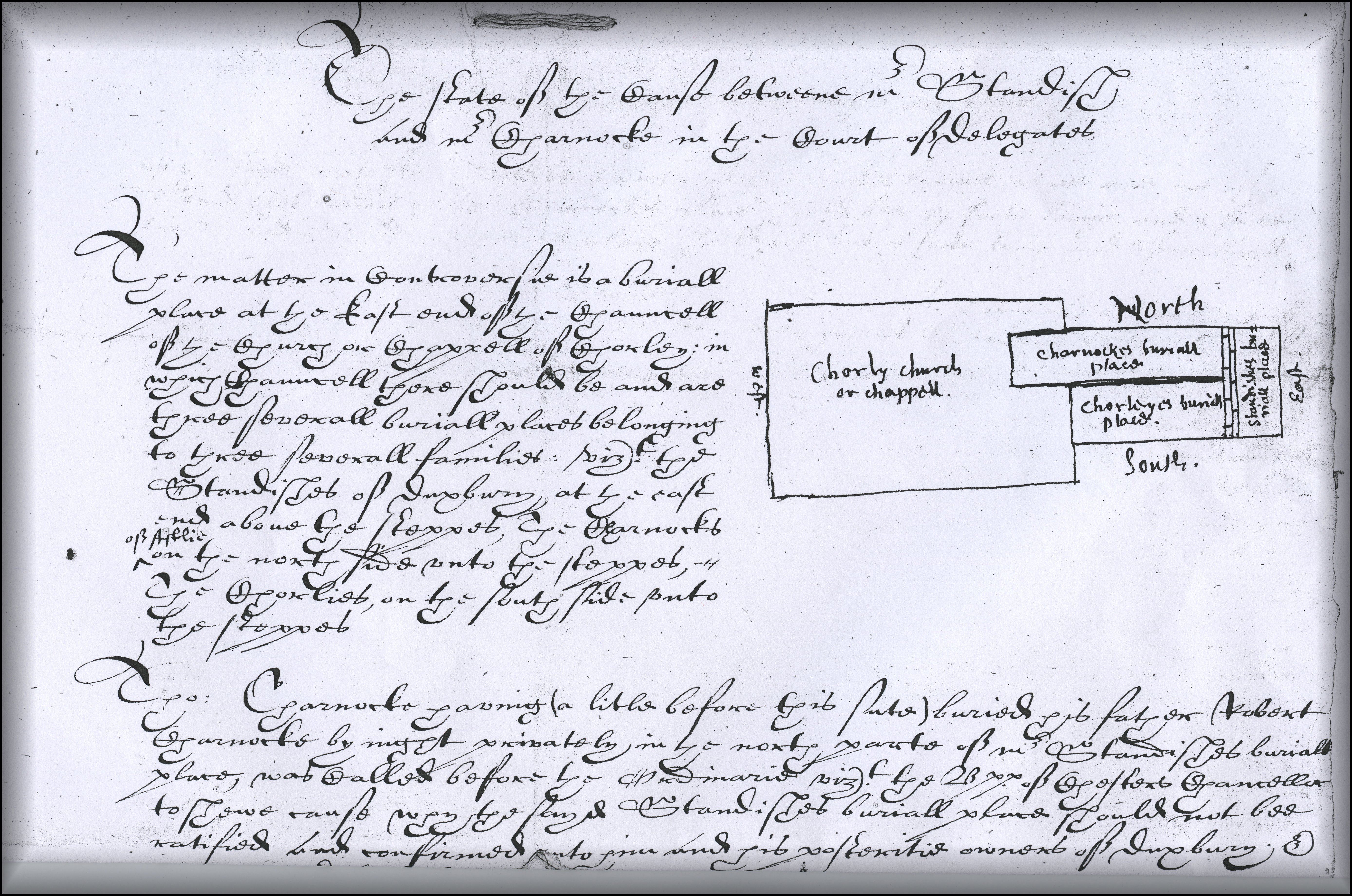
LANCASHIRE RECORD OFFICE - documents of Alexander Standish.
FILE [no title] - ref. DDHK 5/2/83 - date: 1617
[from Scope and Content] Alexander Standish of Duxbury, esquire
FILE - ROLL 21 - ref. QDD/21 [n.d.]
item: Lawrence brendwood of Altham, yeoman, to Alexander Standish of Duxburie, Esq., -- Duxbury
- ref. QDD/21/m17d
- date: 6 October 1613
item: Raphe Assheton of Greate Leaver, Esq. to Alexander Standish of Duxbury, Esq., -- Anglezarke
- ref. QDD/21/m37
- date: 2 May 1614
FILE - ROLL 30 - ref. QDD/30 [n.d.]
item: Rauffe Standish of Standish, Esq., and John Mollineux of
Widnesse, gent. to James Pilkington of Wigan, gent. - Wigan Woodhouses -
ref. QDD/30/m6d
- date: 29 March 1623
item: Christofer Banastre of Graies Inne, Esq.,
and Thomas Sergeant of Newton in Makerfield, gent. (executors of Alexander Standish of Duxburie Esq., dec'd.), to
Henrie Chapman of Lancaster, yeoman. -- Lancaster - ref. QDD/30/m22 - date: 2
April 1624
FILE - ROLL 35 - ref. QDD/35 [n.d.]
item: Christofer Banastre of Grayes In, co.
Middlesex Esq., and Thomas Sergeant of Newton in Makerfield, gent., Executors
of Alexander Standish of Duxburie,
Esq., dec'd., to John Cooke of Scotforth, yeoman, -- Scotforth -
ref. QDD/35/m28
- date: 4 August 1627
THE WILL OF
CAPTAIN RALPH STANDISH 21st DECEMBER 1637. (Son of Alexander)
In the name &c. 21 December
1637.
I Captain Ralph Standish younger son of Alexander
Standish late of Duxburie in the county of Lancaster Esq. deceased
&c. And my body I commit to the earth from whence it came to bee buried in
Christian burial.
And for my goods and personal estate I bequeath the same as herein
is declared that is to say To my brother Thomas Standish xx3 and to
every one of his children except Ratcliffe xxs
My sister Joan and every one of
her children xxs
My sister Alice xxs
her daughter Anne Asshton vu her three children had by her second
adventure to every one of them v11
My brothers Grelibrand Xs
Hamblett Ashton Xs My brother Banaster xs (brothers in law)
My brother Alexander xxs
Alexander his wife Xs his daughter Joan xxs
My ant Elline vu
Sir Ralph Asheton xx5
My uncle Ratcliffe Ashton xxs
The poor of Anglezark Heapey
Whitle Chorley and Duxbury viz* to every townshipp xxs
My nursmam Jane Croston desiring
her to wind me xls
My cousin Henry Ogell xxs
My cozen Thomas Sergeant the
elder xxs
My cousin Katherin Sergeant xs
To William Leigh bachelor of
divinities xls
My cousin Thomas Longworth xxs
My cousin Margrett Crosse xxs
My cousin Jane Asheton xs
John Jameson xs
I bequeath after my debt &c.
are paid all the residue of my said goods &o. unto Ratcliffe Standish
daughter unto Thomas Standish to bee putt forth for her use by my executors
until she come unto years of discretion And I desire that my brother Standish
shall have nothing to doe with it.
And I doe hereby constitute
&c. my brother Alexander Standish and Edward Farnworth of Duxbury bestowing
of them ten pounds apiece for their pains executors of this my last will not
doubting but they will truly execute the same according to my desire and trust
in them reposed.
And now to God bee praise for
ever and ever amen
Memoranda that the goods
hereafter mentioned were given by Captain Ralph Standish in his life time by
word of mouth viz' -
To my Lord Strange one case of
pistols and a dragoon.
To my sister Banaster one beaver
hat one fur coat one cad-owe and a seller of bottles
To my nephew Richard Clayton one
case of pistols three muskets a target a leading staffe powder bag and two
other little pieces
To my brother Alexander his
sword.
To Edward Farnworth a little
ffilde bed.
To Thomas Compton his boy in
money v11 and some of his clothes at the discretion of his executors
To William Nickson one
demicastor hat and some other old clothes at my executors discretion
One old Testament to my sister
Banaster and the rest of my books to any of his friends that desired one at ye
discretion of my executors.
Sealed &c. in presence of
Richard Haydock Edward Wyke.
1622. THOMAS STANDISH, Esquire, M. P., lord of the manor of Duxbury, 1622-1642, son of Alexander and Alice (Ashton) Standish of Duxbury, was born in 1593, died in October 1642, and was buried at Chorley the church of St. Laurence, October 29, 1642.
He married, first, Anne Wingfield, daughter of Sir Thomas Wingfield, Knt., of Letheringham, Suffolk.
He married, second, Anne Whittingham, daughter of Christopher Whittingham, Esquire, of Suffolk.
The family had by this time become Protestant and Thomas was a zealous Parliamentarian, representing Preston from 1640 till his death. (Pink and Beaven, Pari. Repres. of Lane, 151-152.)
A settlement of the manors of Duxbury and Heapey was made by Thomas Standish in1623. (Pal. of Lane.Feet of F.)
His eldest son, Captain
Thomas Standish, however, espoused the king's side and was killed in September,
1642, while taking part in the attack on Manchester. He was buried at Chorley the church of St. Laurence, September 30, 1642.
Children of Thomas and Anne
(Wingfield) Standish of Duxbury:
1. Captain Thomas Standish, Esq., of Duxbury; m. Elizabeth Vaux, dau. of Thomas Vaux of Dotchet;
had one dau. who d. y.
2. Colonel Alexander Standish, Esq.,
lord of the manor of Duxbury, 1642 - 1647 (second son and heir after his older brother Thomas died;
3. Richard Standish, of Duxbury buried church of St. Laurence Chorley 31st August 1628.
4. Anne Standish.
5. Radcliffe Standish.
6. Kattleene
Children of Thomas and (2nd wife) Anne
(Whittingham) Standish of Duxbury:
1. Elinor Standish born 8th April 1627.
1642. Alexander Standish, Esq., the last lord of the manor of Duxbury, (1642 - 1647 from the direct male line in England.
The wives of Alexander Standish -:
(1) Alice Farrington, dau. of William Farington, Esq., of Shaw Hall, a widow.
(2) Margaret widow of Colonel Clifton.
No Children from the marriages.
The End of the Direct Male line of the Standish Family of the Pele Tower.
1647. Margaret Standish widow of Alexander holds as her dower the manor of Duxbury and all other lands and property belonging to the Lord of Duxbury. By a legal transfer in 1647 signed by Margaret Standish and sealed by the lawful seal of the Lords of Duxbury, Margaret transfers her dower (the manor of Duxbury and all other lands and property belonging to the Lords of Duxbury) to a cousin of her husband - Colonel Richard Standish.
Lancashire Record Office. DP375/21/16 - Margaret Standish.
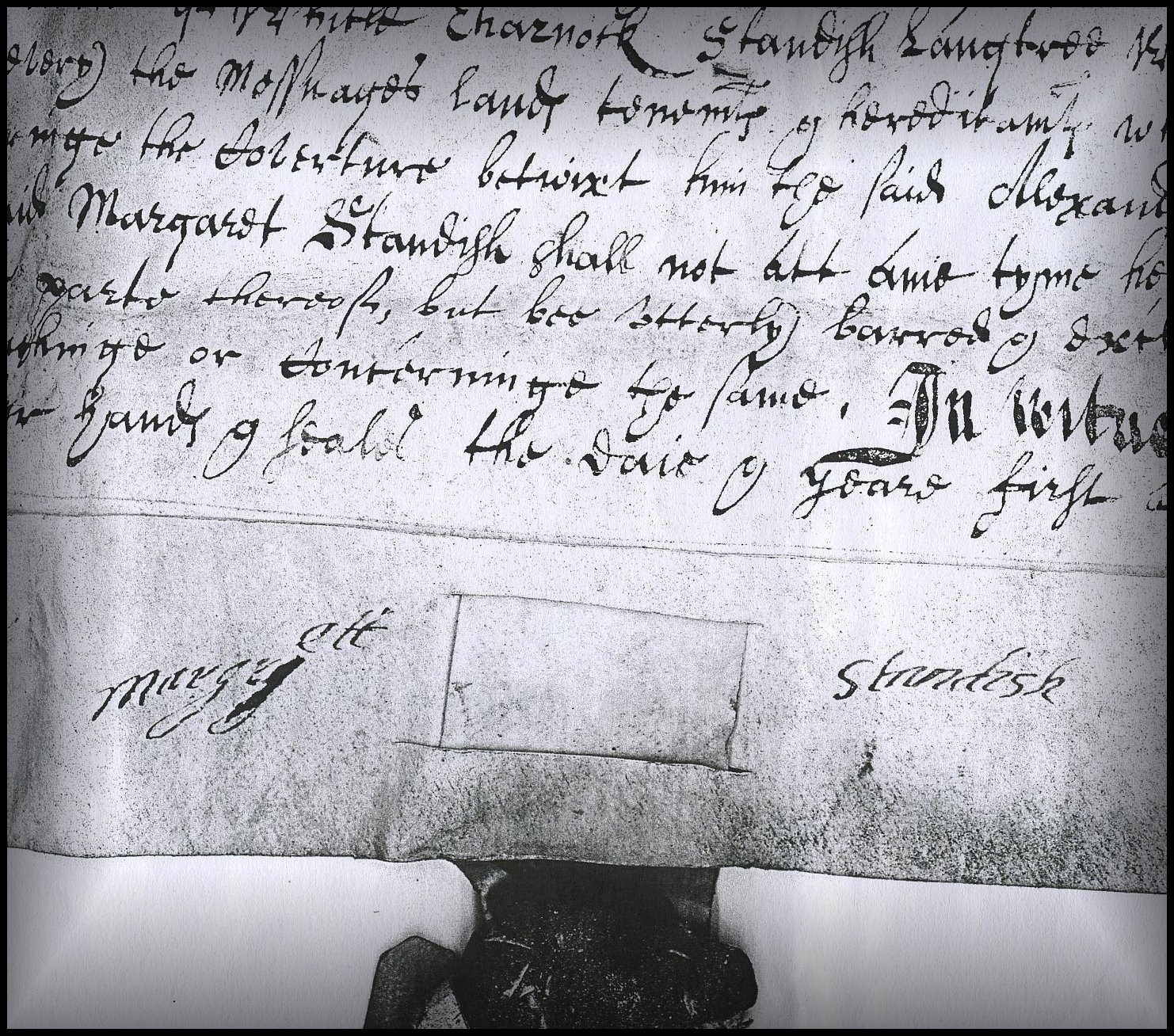
1647 -The new Lord - Colonel Richard Standish and Elizabeth Legh..
![]()
Eleanor Johnson..
Eleanor Johnson in her book "The Standish
Family" (1976) states the basis of the argument for the birth of Myles Standish upon the Manor of Duxbury.
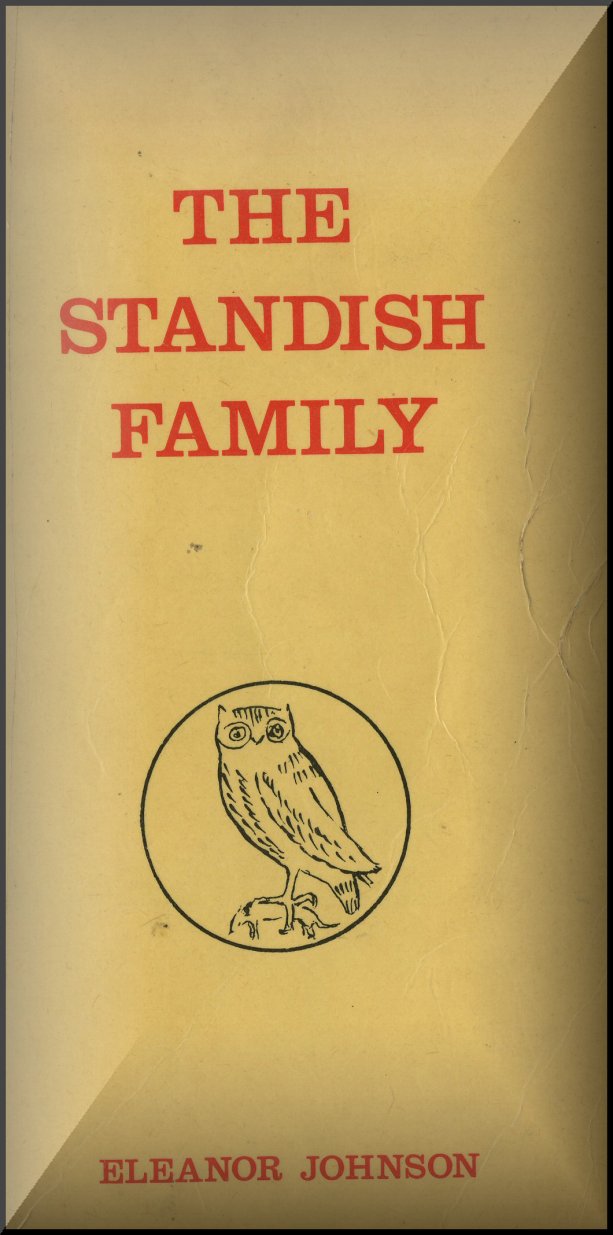

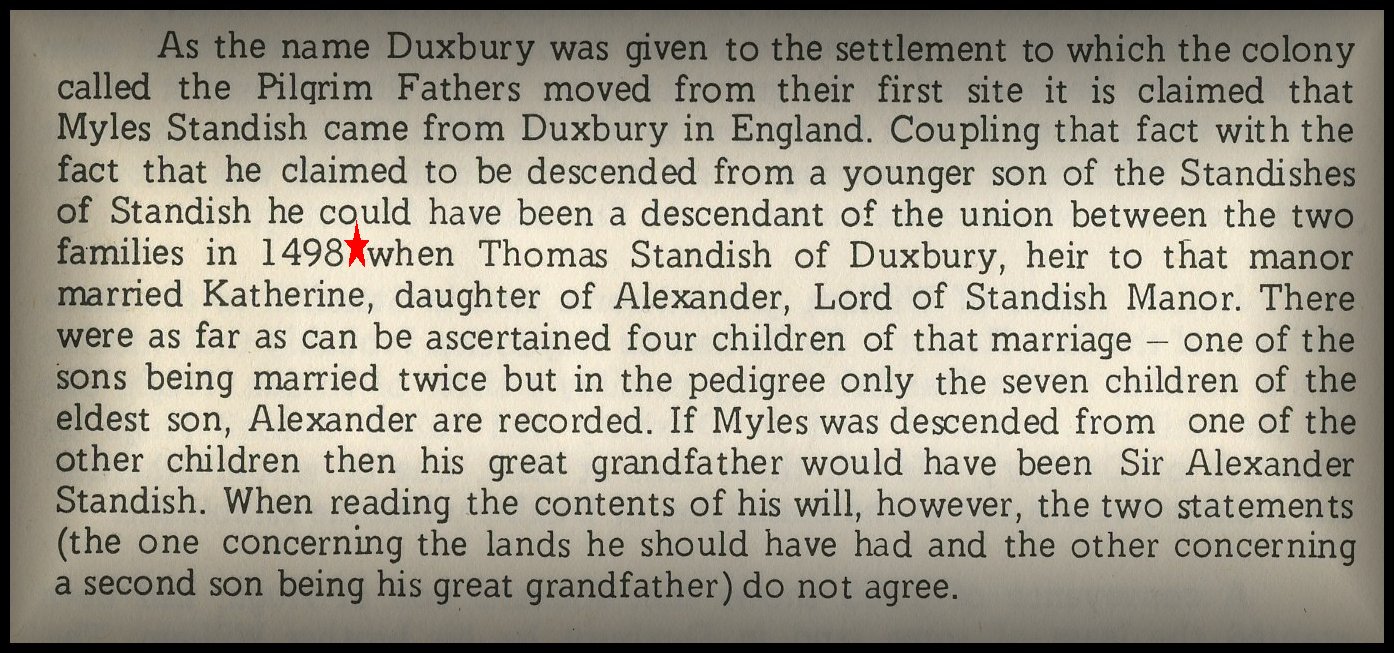
![]()
John Wilson.
John Wilson an eminent local historian in
his book "Chorley Church" published in 1914 conclude that Myles was descended
from Christopher Standish the founder of the Irish and Canadian branches of the
Standish family.
Christopher Standish was the third son of
James Standish Lord of the Manor of Duxbury 1517 – 1565 and he was the great
grandson of Sir Alexander Standish Lord of the Manor of Standish 1468 to 1507.
James Standish son of Christopher is said
to have married a sister of Myles Nightingale of Duxbury.
However John Wilson noted the residence of the Standish family of the Burgh upon the Manor of Duxbury and thus the possibility that Myles was descended from that branch of the Standish family
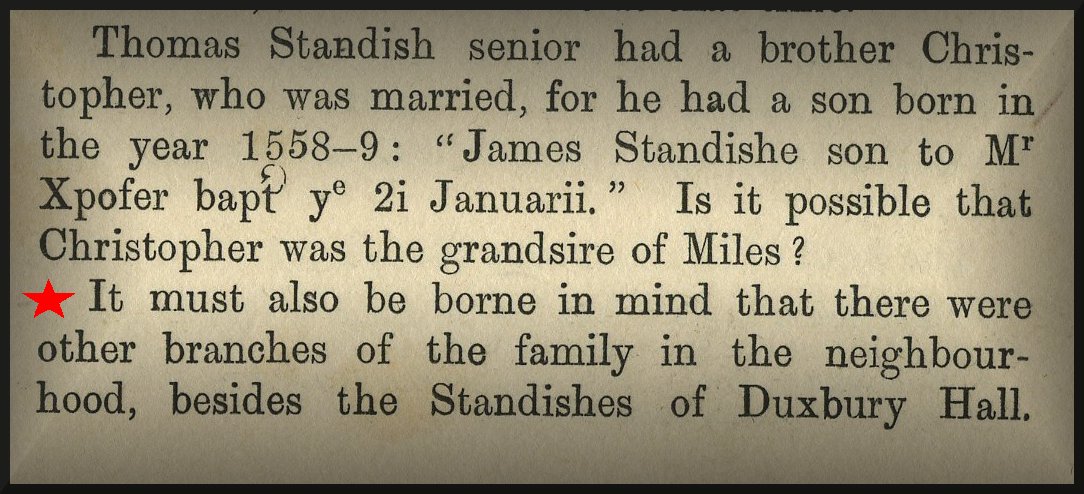
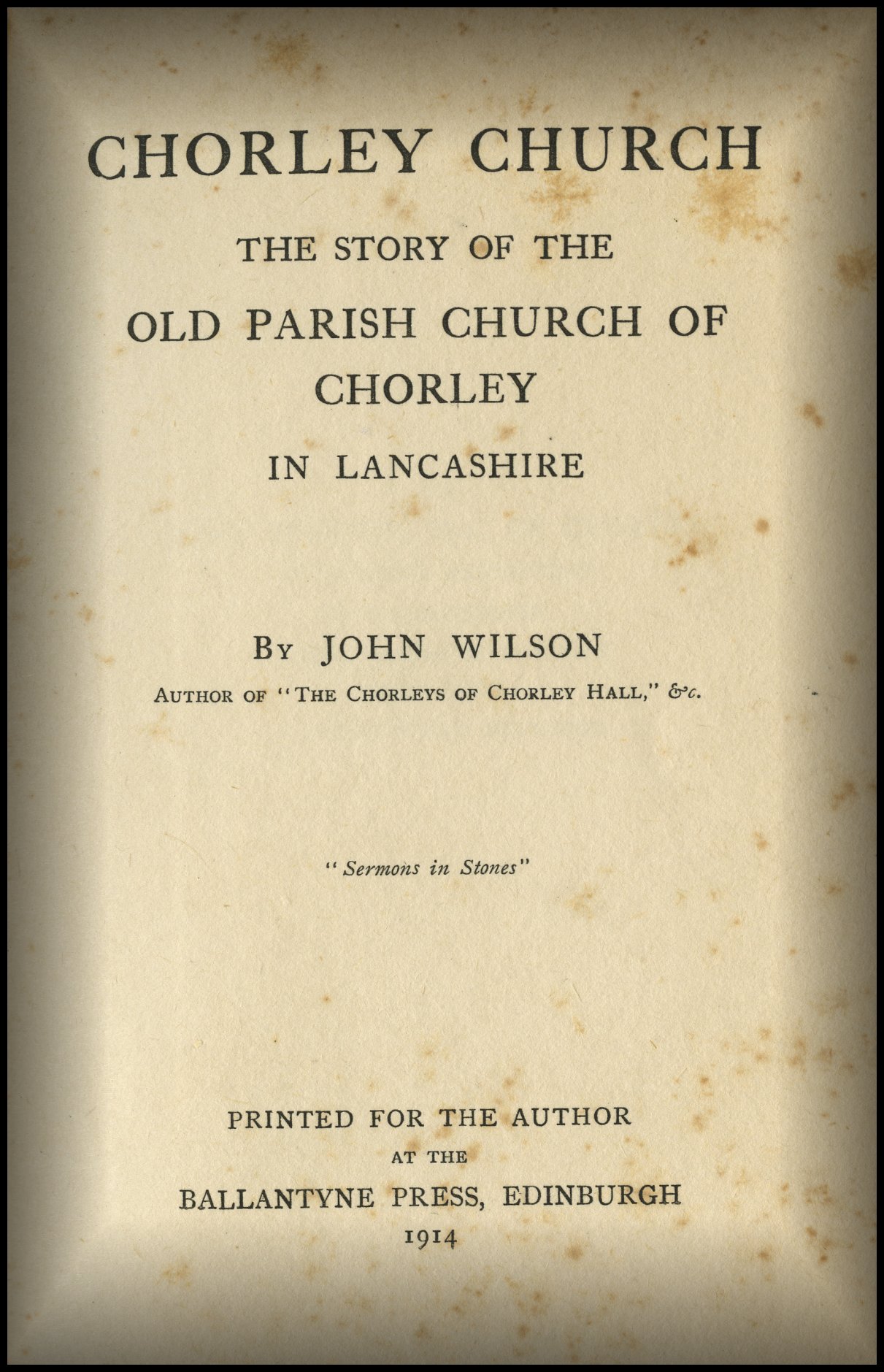
![]()
Residents of the Manor of Duxbury in the year 1584.


![]()